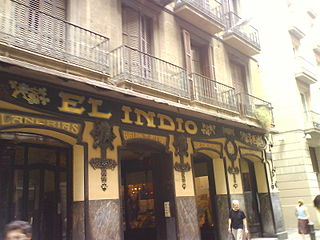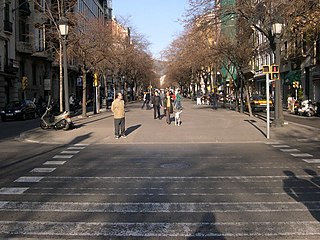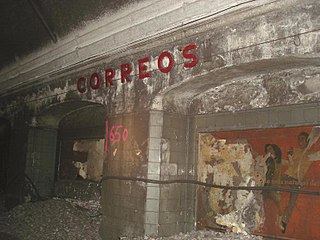
Ciutat Vella is a district of Barcelona, numbered District 1. The name means "old city" in Catalan and refers to the oldest neighborhoods in the city of Barcelona, Catalonia, Spain. Ciutat Vella is nestled between the Mediterranean Sea and the neighborhood called l'Eixample.

La Rambla is a street in central Barcelona. A tree-lined pedestrian street, it stretches for 1.2 km (0.75 mi) connecting the Plaça de Catalunya in its center with the Christopher Columbus Monument at Port Vell. La Rambla forms the boundary between the neighbourhoods of the Barri Gòtic to the east and the El Raval to the west.

The Gothic Quarter is the historic centre of the old city of Barcelona. It stretches from La Rambla to Via Laietana, and from the Mediterranean seafront to the Ronda de Sant Pere. It is a part of Ciutat Vella district.

El Raval is a neighborhood in the Ciutat Vella district of Barcelona, the capital city of Catalonia. The neighborhood, especially the part closest to the old port, was formerly (informally) known as Barri Xinès or Barrio Chino, meaning "Chinatown". El Raval is one of the two historical neighborhoods that border La Rambla, the other being the Barri Gòtic; it contains some 50,000 people.
Line 3, currently known as Zona Universitària – Trinitat Nova, coloured green and often simply referred to as Línia verda, is a metro line in Barcelona operated by TMB, and therefore part of the fare-integrated ATM transport network of the urban region. This V-shaped line is the result of the junction of two related lines: the original L3 and L3B, in 1982. The central section of L3 has the city's oldest metro stations, built in the mid-1920s, with additions almost every decade since then. All of L3 stations are underground.

The Mercat de Sant Josep de la Boqueria, often simply referred to as La Boqueria, is a large public market in the Ciutat Vella district of Barcelona, Catalonia, Spain, and one of the city's foremost tourist landmarks, with an entrance from La Rambla, not far from the Liceu, Barcelona's opera house. The market has a very diverse selection of goods.

Rambla de Catalunya is a major street in the Eixample district of central Barcelona. It is one of the city's trendiest streets, with many international fashion shops, and is lined with lime trees.

Paral·lel is a Barcelona metro station, located under Avinguda del Paral·lel, between the streets of Ronda de Sant Pau and Carrer Nou de la Rambla. It is served by L3, is the southern terminus of L2, and also the lower terminal of the Funicular de Montjuïc.

Correos (Spanish) or Correus (Catalan) was a former Barcelona metro station. The station site is located on what is now line L4 between the existing stations of Jaume I and Barceloneta, and under the street of Via Laietana.

Zona Universitària is a station in the Barcelona Metro and Trambaix networks, in the Les Corts district of Barcelona. It is currently the western terminus of metro line L3 and L9. Also it's served by tram lines T1, T2 and T3. It is named after the Universitat de Barcelona campus of the same name.

Liceu is a Barcelona Metro station situated under the La Rambla between Gran Teatre del Liceu and Mercat de la Boqueria in the Barri Gòtic, part of Barcelona's district of Ciutat Vella. It is served by TMB-operated Barcelona Metro line L3.

Santa Eulàlia is a Barcelona Metro station, just inside the boundary of the municipality of L'Hospitalet de Llobregat with the city of Barcelona, and named after the nearby Santa Eulàlia neighbourhood. The station is served by line L1.

La Rambla | Drassanes is a Barcelona Metro station located underneath Portal de la Santa Madrona, just off La Rambla in the Ciutat Vella district of Barcelona. It is named after the nearby Drassanes Reials de Barcelona, the old shipyards that are now the home of the Museu Marítim de Barcelona. It is the closest station to the Port of Barcelona and one of the network's closest stations to the sea, and is served by TMB-operated Barcelona Metro line L3.

The Barcelona–Vallès Line is an unconnected standard gauge rapid transit and commuter railway line linking Barcelona with Sabadell and Terrassa via the Collserola mountain range, in Catalonia, Spain. Its name refers to the Catalan historical region of Vallès, whereby most part of the line runs. Plaça de Catalunya station serves as the Barcelona terminus of the line, where almost all its trains either start or terminate. The line then continues northwards and branches off twice before leaving the city limits. Its main route splits in two in Sant Cugat del Vallès, forming two major branches to Sabadell and Terrassa. It has 40 passenger stations in operation and a total line length of 48.1 kilometres (29.9 mi).

Bellvitge | Rambla Marina is a Barcelona Metro station, in the L'Hospitalet de Llobregat municipality of the Barcelona metropolitan area, and named after the nearby neighbourhood of Bellvitge. The station is served by line L1. It is some 750 metres (2,460 ft) west of Bellvitge railway station, served by Rodalies de Catalunya commuter and regional rail services.

Avinguda Carrilet, also known as L'Hospitalet Avinguda Carrilet, is an interchange complex underneath Avinguda Carrilet in the L'Hospitalet de Llobregat municipality, to the south-west of Barcelona, in Catalonia, Spain. It consists of a railway station on the Llobregat–Anoia Line and a Barcelona Metro line 1 (L1) station. The Llobregat–Anoia Line station is served by Barcelona Metro line 8 (L8), Baix Llobregat Metro lines S33, S4 and S8, and commuter rail lines R5, R6, R50 and R60. The services on the Llobregat–Anoia Line are operated by Ferrocarrils de la Generalitat de Catalunya (FGC), whilst the L1 is operated by Transports Metropolitans de Barcelona (TMB).
Rambla Just Oliveras is a Barcelona Metro station, in the L'Hospitalet de Llobregat municipality of the Barcelona metropolitan area, and named after the nearby street of Rambla Just Oliveras. The station is served by line L1, and is adjacent to the L'Hospitalet de Llobregat railway station, the main Rodalies Barcelona and mid-distance transport hub in the area.

Maria Cristina is a station in the Barcelona Metro and Trambaix networks, in the Les Corts district of Barcelona. It is served by metro line L3 and tram lines T1, T2 and T3.

The Teatre Principal is the oldest theatre in Barcelona, founded in 1579, built between 1597 and 1603 and rebuilt several times, mainly in 1788 and again in 1848. The theatre was originally named the Teatro de la Santa Cruz in Spanish. It is located on the famous avenue of La Rambla.



















